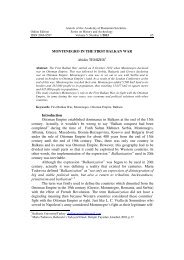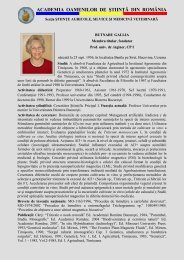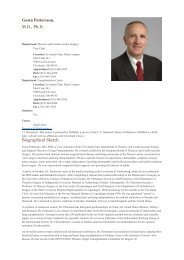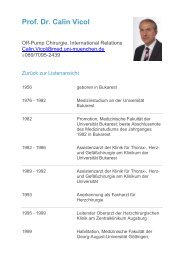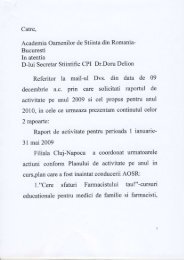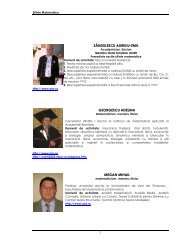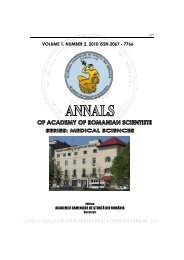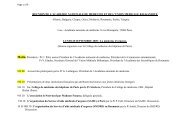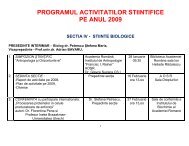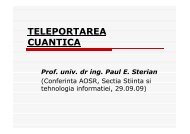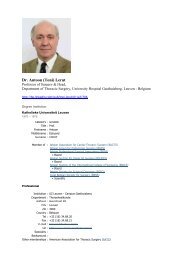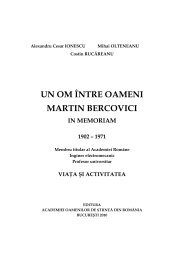ANNALS ANNALES - Academia Oamenilor de Stiinta din Romania
ANNALS ANNALES - Academia Oamenilor de Stiinta din Romania
ANNALS ANNALES - Academia Oamenilor de Stiinta din Romania
You also want an ePaper? Increase the reach of your titles
YUMPU automatically turns print PDFs into web optimized ePapers that Google loves.
40 Mărgărit Pavelescu<br />
of these papers, on Brownian motion, he ma<strong>de</strong> significant predictions about the<br />
motion of particles that are randomly distributed in a fluid. These predictions were<br />
later confirmed by experiment [1].<br />
The second paper, on the photoelectric effect, contained a revolutionary hypothesis<br />
concerning the nature of light.<br />
AE not only proposed that un<strong>de</strong>r certain circumstances light can be consi<strong>de</strong>red as<br />
consisting of particles, but he also hypothesized that the energy carried by any light<br />
particle, called a photon, is proportional to the frequency of the radiation.<br />
The formula for this is E = h., where E is the energy of the radiation, h is a universal<br />
constant known as Planck's constant, and is the frequency of the radiation.<br />
This proposal—that the energy contained within a light beam is transferred in<br />
individual units, or quanta—contradicted a hundred-year-old tradition of consi<strong>de</strong>ring<br />
light energy a manifestation of continuous processes.<br />
Virtually no one accepted AE‘s proposal. In fact, when the American physicist Robert<br />
Andrews Millikan experimentally confirmed the theory almost a <strong>de</strong>ca<strong>de</strong> later, he was<br />
surprised and somewhat disquieted by the outcome [1].<br />
AE, whose prime concern was to un<strong>de</strong>rstand the nature of electromagnetic radiation,<br />
subsequently urged the <strong>de</strong>velopment of a theory that would be a fusion of the wave<br />
and particle mo<strong>de</strong>ls for light. Again, very few physicists un<strong>de</strong>rstood or were<br />
sympathetic to these i<strong>de</strong>as.<br />
3. AE'S SPECIAL THEORY OF RELATIVITY<br />
AE‘s third major paper in 1905, ―On the Electrodynamics of Moving Bodies‖,<br />
contained what became known as the special theory of relativity. Since the time of<br />
the English mathematician and physicist Sir Isaac Newton, natural philosophers (as<br />
physicists and chemists were known) had been trying to un<strong>de</strong>rstand the nature of<br />
matter and radiation, and how they interacted in some unified world picture.<br />
The position that mechanical laws are fundamental has become known as the<br />
mechanical world view, and the position that electrical laws are fundamental has<br />
become known as the electromagnetic world view. Neither approach, however, is<br />
capable of provi<strong>din</strong>g a consistent explanation for the way radiation (light, for<br />
example) and matter interact when viewed from different inertial frames of reference,<br />
that is, an interaction viewed simultaneously by an observer at rest and an observer<br />
moving at uniform speed. In the spring of 1905, after consi<strong>de</strong>ring these problems for<br />
ten years, AE realized that the crux of the problem lay not in a theory of matter but in<br />
a theory of measurement. At the heart of his special theory of relativity was the<br />
realization that all measurements of time and space <strong>de</strong>pend on judgments as to<br />
whether two distant events occur simultaneously.<br />
This led him to <strong>de</strong>velop a theory based on two postulates:<br />
1) the principle of relativity, that physical laws are the same in all inertial<br />
reference systems, and<br />
2) the principle of the invariance of the speed of light, that the speed of light in<br />
a vacuum is a universal constant [2].<br />
He was thus able to provi<strong>de</strong> a consistent and correct <strong>de</strong>scription of physical events in<br />
different inertial frames of reference without making special assumptions about the<br />
nature of matter or radiation, or how they interact. Virtually no one un<strong>de</strong>rstood AE's<br />
argument.



